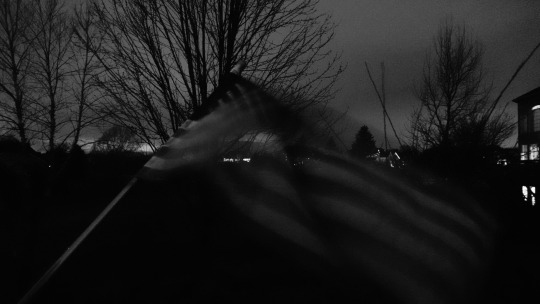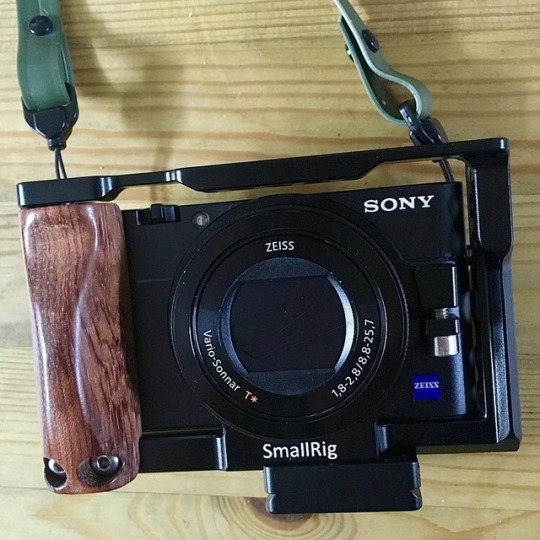#rx100va
Photo

Sony RX100VA (NEWEST VERSION) 20.1MP Digital Camera
https://amzn.to/3Am1ugo
0 notes
Text
Sony RX100VA (NEWEST VERSION) 20.1MP Digital Camera: RX100 V Cyber-shot Camera with Hybrid 0.05 AF, 24fps Shooting Speed & Wide 315 Phase Detection - 3” OLED Viewfinder & 24-70mm Zoom Lens - Wi-Fi
Sony RX100VA (NEWEST VERSION) 20.1MP Digital Camera: RX100 V Cyber-shot Camera with Hybrid 0.05 AF, 24fps Shooting Speed & Wide 315 Phase Detection – 3” OLED Viewfinder & 24-70mm Zoom Lens – Wi-Fi
Introducing a new level of AF performance and speed to today’s compact camera market. The RX100 V boasts the world’s fastest AF speed (0.05 sec.), world’s fastest continuous shooting speed (24Fps) with world’s most AF points 315 for a compact camera NFC: NFC forum Type 3 Tag compatible, One-touch remote, One-touch sharing; Input Output Terminals: Multi/Micro USB Terminal, High-Speed USB (USB2.0),…

View On WordPress
0 notes
Photo

Lauf' nicht vor Dingen weg, die sowieso schneller sind als du. by DOKTOR WAUMIAU (Mirette Kamal) https://flic.kr/p/2hLNhLD
3 notes
·
View notes
Photo

Pulled everything out of my @peakdesign Everyday 30L pack to organize gear for my night dive tonight with some manta rays (super excited). Figure I'd take a pic of #whatsinmybag since I'm laying out all out. Left my @djiglobal #mavicpro in the rental, but you get the idea. Really looking forward to shooting again out here — hopefully the weather cooperates. Cccchhhheeeeeee yeewwwww!!! 🤙🏾 #bealpha . . @sonyalpha @sonyalphagear @sonyalphapro @sonyrxmoments @sonyactioncamofficia @sony #a7riii #a7sii #rx100VA #rx0 #sonyactioncam #peakdesign @michael.pollan @aputuretech #aputure @lacie_tech #lacie @ravpower #ravpower @reef #reefsandals @mefototripods #mefoto #hawaii #bigisland #aloha #aina #mana #volcano #lava #shaka #wimb (at Kailua-Kona, Hawaii) https://www.instagram.com/johnnyv_imagery/p/Bura_pbHxG5/?utm_source=ig_tumblr_share&igshid=fnmehjtk4dya
#whatsinmybag#mavicpro#bealpha#a7riii#a7sii#rx100va#rx0#sonyactioncam#peakdesign#aputure#lacie#ravpower#reefsandals#mefoto#hawaii#bigisland#aloha#aina#mana#volcano#lava#shaka#wimb
0 notes
Text
Sony RX100VA & Ronin-S Test
vimeo
Shot this test over a few days on the Sunshine Coast, British Columbia during Xmas holidays with my Sony RX100VA and Ronin-S to see what kind of results I could get with this very small setup. I recorded about half of the footage in 4K ProresHQ on a Pix-E5 and the other half internally at 4K 100Mbps. All shots set to manual settings mode, 23.98, 1/50 shutter, F1.8-2.8, 1000ISO, 5600K, S-log2/S-Gamut. I tried to keep exposure at +1.7 overexposed using the Multi metering setting. Continuous autofocus seemed to work best set to Center or Zone depending on the shot. I’d record on the Pix until the batteries died then switch to internal recording. I saw no difference between the 2 recording formats which was surprising; the internal codec held up better than expected.
For filters I used an SLR Magic Enhancer Pro and a Tiffen Vari-ND. All shots were graded in Resolve 15.2 Studio and most have image stabilization applied. About half have minor noise reduction. I didn’t have a lot of time to put this together so forgive the quick grade. My base look was the Filmconvert RX100 mk5 profile using the Kodak 5213 stock setting at 75% Film Color and 50% Curve with Grain set to 0.
Takeaways were that an external recorder would not be missed when travelling light and that I could have used an additional stabilizer like the Airflow Duo which I’ve now ordered but not yet received. I felt my steps too much for my liking and am hoping the stabilizer will help. That’s about it, it’s a great combo and easy to carry all day.
0 notes
Text



bought a rx100va (used) for the 4th time. made some art. ‘Merica.
1 note
·
View note
Text
Sony RX100VA (NEWEST VERSION) 20.1MP Digital Digicam: RX100 V Cyber-shot Digicam with Hybrid
Sony RX100VA (NEWEST VERSION) 20.1MP Digital Digicam: RX100 V Cyber-shot Digicam with Hybrid
Value: (as of – Particulars)
Introducing a brand new stage of AF efficiency and pace to at present’s compact digicam market. The RX100 V boasts the world’s quickest AF pace (0.05 sec.), world’s quickest steady taking pictures pace (24Fps) with world’s most AF factors 315 for a compact digicam NFC: NFC discussion board Kind 3 Tag suitable, One-touch distant, One-touch sharing; Enter Output…

View On WordPress
0 notes
Photo

Sony RX100VA (NEWEST VERSION) 20.1MP Digital Camera https://www.gadgetgets.com/sony-rx100va-newest-version-20-1mp-digital-camera/
0 notes
Text
Data structure in c++ pdf by yashwant kanetkar
DATA STRUCTURE IN C++ PDF BY YASHWANT KANETKAR >> DOWNLOAD LINK
vk.cc/c7jKeU
DATA STRUCTURE IN C++ PDF BY YASHWANT KANETKAR >> READ ONLINE
bit.do/fSmfG
Yashavant Kanetkar. C Revision - I. Objectives. The importance of data structures. The data types in C for (c = 0 ; c < cols ; c++ ). Data Structures Through C++ book. Read 2 reviews from the world's largest community for readers. UpdateCancel. Re-Ask. Follow16. yashwant kumar name ringtone (Second Server), Download. Data Structures through C++ by. Yashwant Kanetkar Author: Yashavant P Kanetkar Understanding. Pointers In C The author uses C++ to teach data structures and carefully created animations on the CD to let the Data Structures Through C-Yashavant Kanetkar. April 8, 2017 | Author: Sangam Jindal | Category: N/A. DOWNLOAD PDF - 30.6MB. Share Embed Donate. Data Strucutre Through C++ [Yashavant P. Kanetkar] on Amazon.com. *FREE* shipping on qualifying offers. Data Strucutre Through C++. Sem_3 cs.pdf - Basic operations in Data Structures. Array Insertion & Deletion algorithms. Data Structure using C++ by Yashwant Kanetkar Destiny drew Yashavant Kanetkar towards computers when the IT Accessing Structure Elements Though many C++ and Java based programming tools and.
https://qulesuxomo.tumblr.com/post/666291346876792832/kinetix-5500-manual, https://jurujadocici.tumblr.com/post/666227914196598784/sony-rx100va-manual, https://nonosenobo.tumblr.com/post/666300118368157696/can-you-manually-tune-gibson-g-force, https://vumogagucu.tumblr.com/post/666238877128933376/pdfgrep-regex-example, https://vumogagucu.tumblr.com/post/666238118340509696/icon-qcon-pro-xs-manual.
0 notes
Text
Aproca Hard Carry Travel Case fit Sony RX100 VA/ RX100 VI/ RX100 V/ RX100 IV/RX100 III /RX100 II 20.1MP Digital Camera
Aproca Hard Carry Travel Case fit Sony RX100 VA/ RX100 VI/ RX100 V/ RX100 IV/RX100 III /RX100 II 20.1MP Digital Camera
Price: (as of – Details)
Product Description
Aproca is a professional case manufacturer, committing to creating and functional case to fit perfectly the variety of Electronic products and accessories.The case can be protected your products and travel with you conveniently.
Perfect Fit:
Special molding case fit for Sony RX100VA 20.1MP Digital Camera
Aproca Logo Zipper:
Aproca logo zipper can…

View On WordPress
0 notes
Text
NEW SONY RX100 V M5A NEW/NUEVA VA ,2 YEARS WARRANTY/ 2 AÑOS GARANTIA
NEW SONY RX100 V M5A NEW/NUEVA VA ,2 YEARS WARRANTY/ 2 AÑOS GARANTIA

SONY RX100 V DSC-RX100M5A OR RX100VA – NUEVO MODELO RX100VA / M5A CON EL PROCESADOR MAS POTENTE DE LA RX100 VI / M6
– NEW MODEL RX100VA / M5A WITH THE PROCESSOR AND FIRMWARE OF THE RX100 VI / M6
ALL SPEC OF THE OLDERER SONY RX100 V MORE :
– Deeper buffer (233 files, up from 150) – Proxy movie mode (captures 720p footage alongside 4K capture) – ‘Zone’ AF area mode – Variable size spot…
View On WordPress
0 notes
Photo

Zonnester gecapteerd met de Sony RX100VA (toen m'n rugzak mét die camera erin nog niet gestolen was 😣) op de Kunstberg in Brussel. Checking whether or not the RX100VA was capable of capturing sunstars (before my backpack containing it got stolen 😣), I got this as a result. . . . #sunstar #sunrise #morningsun (bij Mont des Arts) https://www.instagram.com/p/Bvi6HallWdV/?utm_source=ig_tumblr_share&igshid=dh9qoewjzqsu
0 notes
Text
How to choose the best digital camera for you
New Post has been published on https://nexcraft.co/how-to-choose-the-best-digital-camera-for-you/
How to choose the best digital camera for you
Whatever your photography needs, there’s a digital camera that fulfills them. (Kevin Grieve via Unsplash/)
Your smartphone can snap pretty good photos. But let’s face it—it’s not a dedicated photography device, and it shows. If quality photos are your thing, buying a digital camera means you don’t have to settle for blurred, dark shots. Explore the host of dedicated digital cameras, and you’ll enter a world of sharp focus, low visual noise, and optical zoom. Your only problem might be finding a route through all the different makes and models on sale. That’s where we can help.
In this guide, we’ll outline the different types of digital camera you can choose, how much you should expect to spend, and the sort of specs you need to keep an eye on. At the higher end of the market, you’ve got to choose between lenses as well as cameras, and we’ll explain the basics of these, too. Here’s what you need to know.
Camera types
The digital camera market shifts quickly, which means the labels and categories you’ll see as you shop around may be confusing. To make the purchasing process simpler, you can split your options into two major categories. Broadly speaking, you’ve got cameras with attached lenses that you can’t swap out, and cameras with interchangeable lenses that you can.
Traditionally, basic digital cameras have been known as point-and-shoot cameras, or compact cameras. As smartphone photography advanced, point-and-shoots have competed by becoming more sophisticated and expensive. Prices for this category range considerably, from less than $100 to $1,000, though smartphones continue to eat away at the bottom end of the market.
It is only in the optical zoom level—how close you can zoom in without degrading quality—and the choice of manual control where smartphone cameras and lower-end point-and-shoots really differ. Otherwise, the end results are similar, with handsets like the Google Pixel 3 that push what’s possible with a phone camera.
The Sony RX100VA shows off just how powerful compact cameras can be. (Sony/)
At the high end of the compact section, you start to see better image quality than most smartphones. Here, you’re paying for larger sensors, better lenses and more manual control, but all wrapped in a device you can still fit in your pocket or bag. Look at the Sony RX100VA ($898 from Amazon) for example—compact and without interchangeable lenses, but still offering higher-quality pictures thanks to a large 1-inch sensor and on-board image processing.
If you’re gunning for more settings to play with or maximum image quality across a variety of situations, you’ll need to invest in either a digital single-lens reflex camera (DSLR), or a mirrorless one. It’s here that digital cameras are the priciest, and the most bulky, but you get the very best in photo quality and the most control over your pictures.
DSLRs use a mirror-and-prism system to show you what you’re shooting through the camera’s viewfinder. Mirrorless cameras often have a similar form, but lose the mirror. Instead, they use the camera’s imaging sensor, and either a viewfinder or the rear LCD screen for composing shots. Which is better? It’s a tough call, but for many photographers it’s more about what works for them individually rather than any particular spec or feature.
It’s fair to say mirrorless cameras have closed the gap on DSLRs in terms of image quality in recent years, but DSLRs have their advantages too, even if they’re relying on older technology. Some users prefer the optical viewfinder approach, while others are more comfortable with the LCD screen viewfinder that more closely matches the experience of shooting with a smartphone.
The Nikon Z6 is one of the better-value mirrorless cameras on the market. (Nikon/)
Various companies have different names for the mirrorless camera type—like compact system camera (CSC) or mirrorless interchangeable-lens camera (MILC)—but in the end, the category represents any camera that can swap lenses and doesn’t have a mirror inside. The Nikon Z6 ($2,397 from Amazon), for example, is one of the best value mirrorless cameras on the market right now, even though it’s not top of the range.
Both DSLRs and mirrorless cameras start around the $300-$400 range, but can go up over $6,000 for a pro-level DSLR and over $4,000 for a high-end mirrorless body, and that’s before you add the lens. These interchangeable-lens cameras typically offer stronger specs and faster operating speeds than their compact, fixed-lens counterparts. The bigger cameras also often have larger image sensors inside, which typically translates to better overall image quality, especially when you’re shooting in low light.
DSLRs have traditionally offered the best overall performance, but right now it’s too close to call. It is worth noting that buying a DSLR from one of the big manufacturers like Canon or Nikon does open you up to a much bigger lens market, including a whole host of used gear available at cheaper prices on the secondary market. DSLRs are also typically much better on battery life than mirrorless cameras, too. A DSLR like the Canon EOS 5D Mark IV ($2,799 from Amazon), for instance, comes packed with all the shooting options and versatility a pro photographer could want (as well as exceptional image quality).
The Canon EOS 5D Mark IV shows off the flexibility and power of a DSLR and can be bought separately or with lenses. (Canon/)
Finally, you might see the term “bridge camera” as you shop. As the name suggests, these are basically a bridge between point-and-shoot models and the more advanced CSCs and DSLRs. Not everyone uses the term (you may find them bundled with the point-and-shoots), but they usually have more powerful features in terms of manual controls and extra optical zoom, while using only a single fixed lens. They’re a good option for those who want to pay a bit more for a better camera, but don’t want the hassle of swapping lenses. Prices range hugely here as well, from a couple hundred dollars to the low thousands.
You probably already have an idea of which category you’d like to dig into, but as with every gadget purchase, picking a camera is a compromise between power and price. If you want to know how good a camera is, looking at its cost is a helpful shortcut. But many buyers won’t need premium-level features—you can still get high-quality snaps and save yourself some cash.
Camera specs, explained
Whether it’s smartphones or digital cameras, megapixels have long been considered one of the key specs in any photo-taking device. This metric refers to the total number of pixels in a final image file. So, take the Nikon D850 DSLR ($2,997 from Amazon): it shoots images that measure 8288 by 5520 pixels, meaning an effective megapixel count of 45.7. However, megapixels aren’t the only spec that matters. When it comes to higher-end cameras, you’ve got more important details to look out for.
The size of the sensor inside a camera is another important factor in image quality. A larger sensor will pick up more light, giving you better shots, whether it’s broad daylight or the middle of the night. A bigger, better sensor also effectively gives you more options in terms of depth of field. If you want that effect where the subject is in focus and the background is wonderfully blurry, a big sensor will help. Of course, as the sensor size increases, so does the camera’s price.
Ah, a crisp foreground subject and a blurry, unimportant background—that’s the stuff. (McKinley Law via Unsplash/)
Here’s the terminology to keep in mind: full-frame sensors are the largest (the size of a 35-millimeter piece of film), followed by Advanced Photo System type-C (APS-C), 1.5-inch, and then Micro Four Thirds. You’ll often find 1-inch sensors in high-end compacts. It’s worth noting that the sensors don’t measure 1 inch in real life, but follow a designation based on an archaic standard linked to video technology.
Zoom levels are pretty simple to understand. Essentially, they let you get closer to the action, and this is where digital cameras beat smartphones. While the very latest cellphones have 5x optical zoom—the genuine, no-loss-of-quality type of zoom—this is still a rare feature for a phone, and even the most basic point-and-shoot will match or go way beyond that. That’s because a camera lens has a lot more physical space to work with.
You might also see ISO range listed with a camera. ISO is a measure of the device’s sensitivity to light. One of the advantages of digital photography in general is that you can adjust ISO on the fly, something you can’t do with film.
While sky-high ISO ranges are good marketing tools (some manufacturers push the number into the hundreds of thousands), you should know that the higher you go, the more digital noise you’ll see in your photos.
So when you’re shopping, look for both the ISO range (the different levels you can pick) and the “native” or “base” ISO (the levels you can get without adding noise).
Many digital camera manufacturers also tout autofocus (AF) capabilities, which means how quickly and accurately a model can fix on its subject. Phase detection AF beats contrast detection AF for speed in most scenarios, though modern mirrorless cameras often use a hybrid system that combines elements of both. You might also see a list of the number of autofocus points, with higher-end cameras offering more of them, and thus more accuracy in your focusing.
Lens specs
You can pick up your camera with all kinds of extras, including multiple lenses. (Nikon/)
If you plan to shoot many different types of photos—from night-time party shots to landscapes—you may need to buy some extra lenses. Whether you’re looking at a fixed- or interchangeable-lens camera, you’ll see some technical terms in the lens specs. The f-number is how wide the lens aperture can open to allow light in—the wider the better. It gets a little tricky because a lower f-number actually indicates a wider aperture.
So, a lens with a maximum aperture of f/1.4 will let in more light than a lens that can only open to f/2. Lenses that don’t zoom typically open wider than those that do, so you have to consider which is more important when buying a new lens. The f-number of your lens also has a huge effect on the amount of depth of field you get in a photo. The more wide-open you shoot, the less depth of field you have and the more background blur you’ll see. This is why portrait photographers typically use a very fast lens to isolate their subjects.
The other number you’ll see is focal length. This number is typically used as shorthand to indicate the angle of view you’ll get when it’s attached to your camera. It gets a little complicated when you talk about cameras with different sized sensors, because that can actually change the effective angle of view. Most entry-level and even mid-level DSLRs ship with a “kit lens” that has a focal range of 18-55 millimeters. That’s what’s called a “standard” zoom because it goes from wide-angle up to a short telephoto on the long end.
Other buying tips
The Sony A7R packs in a full frame 42.4-megapixel sensor to capture as much light as possible. (Sony/)
We don’t exaggerate when we say we could write an article three times this size and not cover every aspect of digital cameras, but don’t get overwhelmed—there are plenty of professional and user reviews on the web to give you a better idea of what a particular camera can do and how it will suit your needs.
We haven’t mentioned video yet, but most higher-end cameras are capable of shooting acceptable 4K footage. If you’re going to be recording a lot of clips in addition to stills, look out for a camera that can handle video well. Also look for image stabilization (IS), which limits camera shake and keeps your shots and video clips looking sharp.
If you really want to progress with your photography skills, look for models that give you all the manual controls (for ISO, aperture size, and so on) that you’ll need. If you just want the best results from pointing the camera at something and hitting the shutter button, these manual controls aren’t as important. Plenty of cameras hit a sweet spot between quality auto modes and more granular control. Again, it’s something to look out for in reviews.
Here’s another thing to bear in mind— just because a camera is a few years old doesn’t mean it’s no good. Modern-day digital cameras age much better than smartphones. By going for slightly dated hardware, you can save yourself some cash and still get a perfectly decent device. Look for refurbished or second-hand options to save even more money.
That also means the money you’re spending is an investment, so factor that into your budgeting. Your camera of choice is going to be snapping away for years to come, so it might be worth spending a little extra at the beginning. Remember to add the cost of accessories, like bags and lenses, to the cost of the camera itself.
The Panasonic Lumix DC-ZS70S may be compact, but it can still shoot in 4K video. (Panasonic/)
To get the most out of your new camera, you’re going to want to shoot photos in raw mode, which means you’ll also need a more advanced editing software solution. Adobe’s Photoshop Lightroom (from $10 a month) is the most popular option for its balance of a simple interface and advanced editing tools. Capture One Pro (from $299) is another excellent option, but it has more of a learning curve and is more expensive (albeit a one-off fee rather than a subscription). Whichever one you pick will be able to help draw out more detail from a raw file than you could get from a camera that simply spits out JPEGs.
With specs improving and prices dropping all the time, there’s never been a better time to buy a digital camera. Once you start sifting through the different models on sale, you’ll find the specs aren’t quite as confusing as they first appear, and with this information, you should at least have a handle on the basics to help you narrow down your selection. Enjoy your camera shopping!
Written By David Nield
0 notes
Text
Luminar Giveaway! Win A Free Copy Of Luminar 3
My friends at Skylum released an update to Luminar today. To celebrate, let’s do a Luminar giveaway! I have a free Luminar license for one lucky winner. The giveaway will run for one week from the posting of this video. In one week, I’ll select a winner at random and get you your license key.
This contest is taking place on my YouTube channel. To enter for a chance to win a FREE copy of Luminar, go to the video on my YouTube page and leave a comment telling me what feature of Luminar you want to try out most! Double your chances to win! Subscribe to my YouTube channel and you’ll get an extra entry in the giveaway.
Use offer code SDP10 at checkout
So what’s new in Luminar 3.0.2? The major improvements are:
Faster adding (Windows): Experience faster load times when adding new photos and folders to the Catalog.
Faster launching (Windows): When returning to Luminar, launch times are improved when reloading a Catalog.
Improved moving (Mac): When files are moved between an external and internal drive, the images are not duplicated multiple times in your library.
Improved sRGB exports (Mac): Some cameras showed color shifts when exporting with the sRGB profile, which has been fixed.
Improved Luminar 2018 import (Mac): Importing and opening native Luminar files (.lmnr files) has been improved.
Stability (Windows and Mac): Luminar 3.0.2 offers greater stability improvements.
Locate Folder: Reconnect misplaced or moved master folders to a Luminar catalog
Other improvements include:
Windows users will see several new features throughout the program to help them better organize and edit photos:
Subfolder management: Users can now create and delete nested folders inside their catalogs.
Offline file alerts: Users will see a visual alert indicating unavailable files and folders.
Shortcut keys: New keyboard shortcuts are available for View, Looks Navigation, Masks, Tools and Edit.
Adding folder improvements: Users can now cancel the addition of folders.
Mac users will also see several new features and improvements:
Database management: Luminar image catalog databases are now automatically backed up to preserve edits and metadata.
Preference panel: Users can control preferences for Cache, Catalog and Automatic Backup.
Improved handoffs: If users are working with RAW or 16-bit image files and use the File > Open In command, a high-quality 16-bit file is exported.
Aurora HDR integration: Users can now send their photos to Aurora HDR, allowing them to merge bracketed photos and take advantage of Aurora’s powerful HDR features.
Adding folder improvements: Users can now cancel the addition of folders.
New camera support. Luminar has support for several new cameras:
Nikon: D3500, P1000, Z6, Z7
Panasonic: Lumix DC-LX100 II
Fujifilm: GFX 50R, X-T3
Sony: RX100VA, RX100VI, DSC-HX99, DSC-HX95
Leica: M10-D, M10-P, D-Lux 7
Pricing
Mixed-computer households can share the same product key for Mac and PC which can be activated on 5 devices.
Limited offer: February 12-17 $49/€49/£45 for all new users;
$69/€69/£64 for all new users;
30-day trial and 60-day money back guarantee.
Limited Time Offer
Get Luminar
Save US$10 on Luminar with offer code SDP10
Luminar Training
Photo Gear I Use
Sony A7Rii
Sony FE 16-35mm F4 ZA OSS
Sony FE 24-70mm F4 ZA OSS
Sony FE 70-200mm F4 G OSS
Really Right Stuff Tripods
Formatt-Hitech Filters
MindShift Camera Bags
The entire list is in The Gear Box.
0 notes
Photo

Repost from @mhiphotography SONY RX100VA ——- #hongkong #travel #memory #sony #sonyrx100va #sonyimages #smallrig #carlzeiss #hkig #hkiger https://www.instagram.com/p/BnXP8H2gaoP/?utm_source=ig_tumblr_share&igshid=2eqz0ak5all9
0 notes